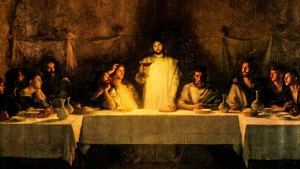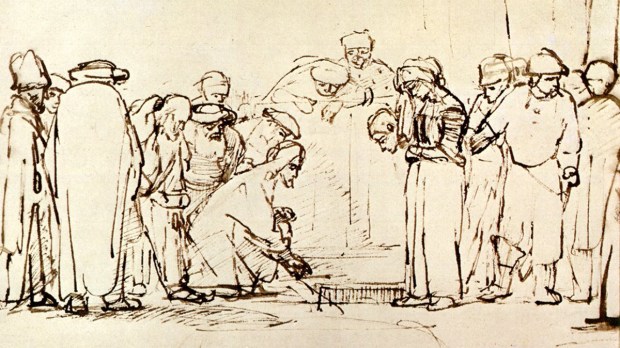Most of the ideas and practices of the very early centuries of Christianity can be safely understood as derived from those we understand to be typical of the Judaism of that period. Much of the most compelling evidence for the Jewishness of these early communities comes from the New Testament itself, Paul’s Letter to the Galatians in particular. In it, we find a kind of (very Pauline) summary of the noted Peter vs. Paul “incident at Antioch,” and their respective views on whether those converted from paganism to Christianity had to observe all the tenets of the Law of Moses. In fact, a number of these Mosaic practices are still clearly preserved in some African and Mediterranean Christian traditions.
These nuances aside, the Gospels are commonly read as marking a radical break from Judaism. In fact, Jesus’ own preaching is often (mis)understood as being at odds with the Mosaic Law — despite his saying he did not come “to destroy the Law or the Prophets […] but to fulfill them.” This is still a matter of seemingly infinite scholarly discussion —the famous “parting of the ways.” Was Jewish Christianity (the ideas and practices of the early Palestinian followers of the Jesus movement) a form of Judaism or something entirely different? To what extent is Christianity really a new development that grew out of Judaism? The famous passage found in Mark 7:18 (“Nothing that enters a man from the outside can defile him, because it does not enter his heart, but it goes into the stomach and then is eliminated”) has more often than not been seen as a definitive rejection of Jewish dietary practice and, consequently, as an affirmation of Christianity as something else entirely.

But the fact that we refer to a “Judeo-Christian tradition” with relative ease speaks of a kind of continuity between Judaism and Christianity — at least, from a Christian perspective. This continuity is all the more persuasive when one realizes that the Gospels describe Jesus himself as a pious Jew and a staunch defender of the Torah. Understanding Jesus’ own unyielding adherence to Jewish tradition and law can help us understand some often misunderstood passages in the gospels in unsuspected, fruitful, and enlightening ways.
One of those passages is found in the eighth chapter of John’s gospel. It reads as follows:
The scribes and the Pharisees brought a woman who had been caught in adultery; and making her stand before all of them, they said to him, “Teacher, this woman was caught in the very act of committing adultery. Now in the law Moses commanded us to stone such women. Now what do you say?” They said this to test him, so that they might have some charge to bring against him. Jesus bent down and wrote with his finger on the ground. (Cf. Jn 8:3-6)
What was Jesus writing?
Tradition has read many different things in this gesture. Augustine saw in Jesus’ writing in the sand an echo of God’s “writing” the 10 commandments in stone, thus establishing himself as a lawgiver, à la Moses. This is a classic Augustinian gesture —always reading the New Testament in a strict typological relationship with another passage from the Hebrew Bible, as he famously understood the Old Testament as being revealed in the New, and the New as concealed in the Old. Jerome thought he was writing down the names of the woman’s accusers, in a reference to a famous passage found in Jeremiah, “all who abandon you will be put to shame. They will disappear like names written in the dust” (Cf. Jeremiah 17, 13). Others think he was writing down the sins of the accusers themselves, as to show them no one is without sin. And more contemporary scholars consider he might have been mimicking a court of law, writing down both the crime (adultery) and the corresponding sentence (death). All of these interpretations are correct, and compatible with each other.
But not only the content of what he might have written is important. The gesture itself also is: he was writing on sand.
According to the Law of Moses, whenever someone was caught in adultery, both the man and the woman had to be prosecuted — as adultery, obviously, involves two persons. The law also required bringing at least two witnesses, in order to confirm that adultery had indeed been committed, before bringing judgment, and there is no mention of any witness in the scene. In this instance, the accusers had only brought the woman, in a flagrant violation of the law.
But, more interestingly, in these cases the priest was required to write the law that had been broken, along with the names of the accused. Yet this writing had to be done on a surface that could guarantee the marks were not permanent, and the dust of the floor of the Temple was the most common place to do so. This, as a symbolic reminder that even though the commandments were indeed written in stone, mercy does away with sin — the law endures, but sin is forgiven. By writing on the sand, Jesus was not only reminding the accusers of this merciful traditional gesture, but also strictly adhering to proper procedure, thus showing the accusers that even if they were not keeping the law, he would.
But the passage shows Jesus as writing on the ground not once, but twice. The text reads:
When they kept on questioning him, he straightened up and said to them, “Let any one of you who is without sin be the first to throw a stone at her.” Again he stooped down and wrote on the ground. At this, those who heard began to go away one at a time, the older ones first, until only Jesus was left, with the woman still standing there.
It has been argued that, at first, Jesus was writing down the name of the woman, her crime, and the corresponding punishment. But this second time (“again he stooped down and wrote on the ground”) he might have been writing the names of the accusers and their crime — accusing a woman of adultery, with no witnesses, and without bringing the man who was complicit in her crime to be accused as well, as the law demanded. Properly instructed in the Law as they were (the text explicitly says they were Teachers of the Law and Pharisees), the accusers surely understood they were now the ones being judged.


